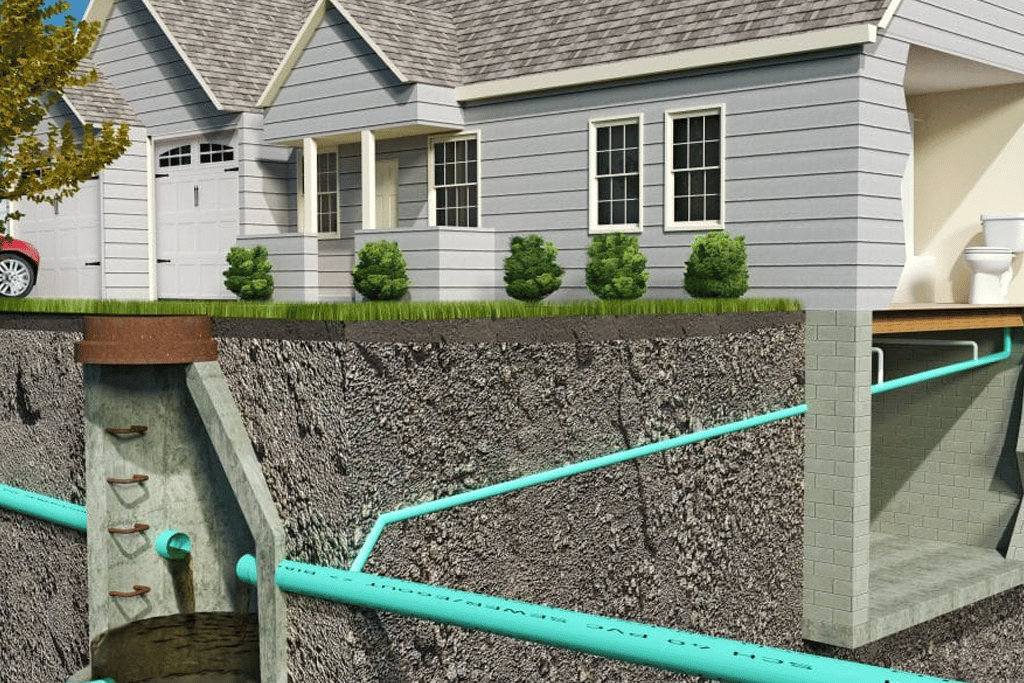While it is true that nothing is softer than water…it is also true that nothing can resist the power of water to penetrate, undermine, and erode even the strongest materials. Water sometimes causes harm in a dramatic way, such as flooding…but more often, water on and under a property can quietly and invisibly damage the foundation, leading to further damage in the walls, floors, and plumbing or electrical systems. In this article, we will show you how to check your property for common drainage issues, how to solve common issues on your own, formulate a drainage plan, and when to seek advice from a professional foundation engineer.
Gutters and Downspouts
The roof of your home has two jobs: to keep you dry when it rains, and to send those hundreds of gallons of water away from the house. By catching the water in gutters and directing it into downspouts, you prevent the rainwater from saturating the soil around your walls and foundation. When rainwater flow is allowed to fall directly from the roof eaves, it erodes the soil and forms low spot pools which allow more water to stand and penetrate the soil directly at the foundation. Saturated soil also increases hydrostatic pressure, which pushes harder against the walls of a basement or the surface of a slab. This drainage issue can lead to water seeping into porous concrete, freezing and widening existing cracks, and repeated cycles of soaking and drying causes the soil to alternately swell and shrink, sometimes with enough force or persistence to break a concrete slab or a brick pier. To protect your foundation, the first line of defense is to keep your gutters clean and to make sure downspouts are directing water well away from the house, not just onto the ground. If necessary, you can add drainage pipes to move downspout water well away before allowing it to flow into the ground.
Grading
The soil under your house may have been backfilled and graded during construction. If so, it may not be compacted as tightly as the natural surrounding earth, allowing water to penetrate more easily near the foundation. Do your lawns provide gradual slopes away from the house? When heavy rain overwhelms the ability of your soil to absorb water, the excess must be directed away from your walls and foundation. Do surface depressions or sunken areas of your yard trap water? Does your patio or shed allow water to form puddles or flow back toward the house? When these issues call for moving water away from a trouble spot, a French or a surface drain are proven solutions. A surface drain is a simple ditch designed to improve landscape drainage, running a solid pipe through the problem spot to a location that is better drained. What is a French drain? A perforated pipe is placed in a ditch and covered with gravel. As rainwater gathers near the French drain, it falls quickly through the gravel and is carried away by the pipe. A SWALE IS LIKE A SMALL EARTHEN DAM THAT REDIRECTS WATER. IT IS NOT A DITCH. In some cases where rains are frequent and pooling water is extensive, it can become necessary to completely re-grade a property to keep water away from the foundation. A recurring problem should be evaluated by a foundation engineer.
Landscaping
Even small hedges and ornamental plants can help water penetrate the soil, clog drainage pipes, or widen small cracks anywhere in the foundation. To protect your foundation, remove landscape plantings that are too close to the house.
Patios and Walkways
The sidewalk in front of your home, the front walkway to the door, the patio, and the paved pathways along the sides of the house can act as either dams or aqueducts, depending on their level and pitch. A raised sidewalk may prevent water from flowing to the street. A concrete walkway that has been tilted by tree roots may be forcing water back toward the house. To evaluate these conditions, watch the water on your patio and walkways during heavy rain. If a walkway is interfering with drainage, one good strategy is to remove poured concrete and replace it with pavers and gravel, allowing water to both passes through the walkway and sink into the soil.
Moisture in the Basement
Hidden drainage problems often show up in a basement. Some basements are equipped with sump pumps to deal with intermittent water, but more subtle signs of moisture may also indicate a persistent drainage problem. These signs may include water stains, mildew, and masonry conditions such as efflorescence and spalling. Efflorescence is a white or gray crust forming on walls. Spalling is when the masonry flakes off in patches. Both conditions are caused by exposure to water. A superficial crust may not be a serious problem. However, when spalling is deeper than a half-inch, it is time to call for an inspection by a foundation engineer.
Sand, silt, and clay
If your lawns seem to be muddy in one spot and dry in others, take a look at the composition of the soil. The most basic types of soil are sand, silt, and clay. Sandy soil allows water to pass through quickly. In North Texas, the most common soils are clays, which tend to hold water. Fill earth is sometimes trucked into level building lots, so you may have a mixture of clay and other soils. Does your home have a pool? Pool builders sometimes use the excavated earth or other soil to backfill the structure, with varying effects on drainage. This should always be checked in clay soils. NTX clay soils will hold that water all day. This is not applicable to North Tex.
Preventing Erosion
If your home is built in a hilly area, you could find yourself dealing with rain from your own downspouts, plus your neighbor’s runoff. In such cases, you will definitely need a strategy for moving the combined runoff across your lawns, or you will lose soil to erosion every time it rains. One strategy is to provide a permanent catch basin which gathers water, traps any debris with a grate, and pipes the runoff across your yard to adjacent street drains. This can be very effective as long as the runoff is not carrying too much silt or debris, which can clog the pipe. Another effective solution is a dry creek bed. This is a functional landscape structure that directs rain and runoff through a small valley lined with stone or gravel. A dry creek bed can be designed as you would an attractive water feature, with an EPDM rubber liner to hold the rocks permanently in place, preventing the accumulation of soil between rocks and keeping the water moving efficiently.
When to Call an Expert
Should you find that despite your best efforts, drainage remains a problem…or if you should find signs of water damage such as basement spalling or cracks in your slab, walls or floors…it’s time to call a foundation engineer for an expert opinion. The engineer’s report will put you on the right path to permanent solutions, and long-term security for your home investment. For more information, please visit Crosstown Engineers, or to schedule an inspection, call Crosstown today at 469-751-7694.










